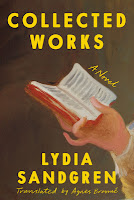Book Review:Collected Works by Lydia Sandgren (translated by Agnes Broome)

My Rating: 3.5⭐️
“Human memory is unreliable, that was one thing all subfields of psychology agreed on. An individual’s life story was a morass of fragmented recollections, other people’s narratives, unconscious incitements to direct one’s attention this or that way. Experiences and events were forgotten, invented, merged and warped.”
Almost fifteen years ago, thirty-three-year-old Cecilia Berg noted historian and translator left her family and was never heard from again. Her husband, publisher Martin Berg, co-owner of Berg & Andrén, which is about to celebrate 25 years in the publishing business, was left to raise their children, ten-year-old Rakel their daughter, and their son Elis who was only three at the time. Cecilia’s family – her parents and siblings and Martin’s best friend, renowned painter Gustav Becker have been stable fixtures in the life of the Bergs. Martin was once an aspiring novelist who, though having published short stories in the past has been unable to finish his novel. Family obligations, full-time engagement at his publishing house, writer’s block and lack of motivation have contributed to his being unable to follow through on any of his ideas.
In the present day, billboards advertising a retrospective of Gustav’s works scheduled to be held in an art museum featuring Cecilia, who was the subject of many of Gustav's famous paintings bring back memories for both Martin and Rakel. When Rakel is handed a novel that Martin’s publishing house has received for translation purposes, she discovers that one of the main characters is shockingly similar to her missing mother, motivating Rakel to go on a quest to find out what happened to her mother all those years ago. Why did she leave and where is she now?
Collected Works by Lydia Sandgren (translated by Agnes Broome) is a slow-paced, contemplative and immersive novel that touches upon themes of family, friendship, loyalty, art and literature. The larger part of the narrative presented from the perspectives of Martin and Rakel is uneven and nonlinear, jumping back and forth, often abruptly, between past and present. The tone varies between nostalgia, melancholy with lighter moments and shades of humor woven throughout the narrative. The coming-of-age narrative focusing on Gustav and Martin’s youth takes precedence over the element of mystery surrounding Cecilia’s disappearance. Martin’s friendship with Gustav, their dreams and convictions, disappointments and youthful indiscretions and exploits are explored in much detail as his Martin’s life before, with and after Cecilia. Cecilia’s disappearance and the mystery surrounding the same is presented to us in fragments, with much of the narrative going back and forth focusing on Gustav and Martin’s and later also Cecilia’s friendships with one another. The characters are complex and the author does an exceptional job of developing the characters, even the minor ones, and exploring the dynamics of human relationships. The discussions on literature, art, psychology and philosophy interspersed throughout the novel enrich the narrative. I should point out that the writing is detailed and descriptive. At over 600 pages this is a lengthy novel and a slow-paced one at that. It took a while for me to fully engage with the story and didn't quite feel invested in any of the characters. I found certain parts a tad repetitive. While I appreciate the scope and depth of the novel and the elegant prose, I was less than satisfied with the abruptness of the ending and the resolution of the mystery did leave me with more questions than answers.
Many thanks to the author, Astra Publishing House and NetGalley for the eARC of this novel. All opinions expressed in this review are my own.
Comments
Post a Comment